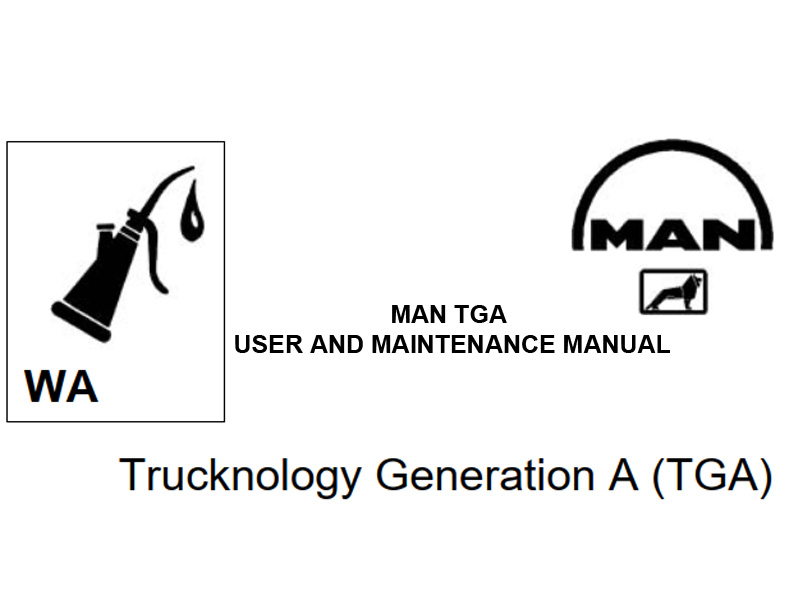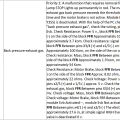- Home
- Manuals
- MAN Trucks
- MAN TGA User and Maintenance Manual
MAN TGA User and Maintenance Manual

MAN TGA Operator's and Maintenance Manual
The Maintenance Manualincludes details of the maintenance type and a description of maintenance work. For details of special bodies and attachments as well as additional equipment, please refer to the service documentation provided by the manufacturer concerned.
Maintenance work must be carried out properly and at the specified intervals in order to ensure constant vehicle availability, road safety and a long vehicle service life. Recommended maintenance work which requires specialist knowledge may only be carried out by qualified personnel.
You will find a detailed explanation of the MAN maintenance system and the intervals at which the various services are due, depending on the maintenance group, in the current "Maintenance Recommendations and Recommended Service Products" booklet.
Confirmation that maintenance work has been performed correctly and at the specified intervals is to be entered in the "Maintenance Record" together with the relevant details.
In the event of claims under warranty, evidence must be brought that proper maintenance was carried out at the specified intervals, that approved or recommended service products were used and that genuine MAN spare parts were installed.Therefore, we would ask the vehicle owner to always have the maintenance work carried out only in authorised service centres and the staff of the service centres to follow the instructions and recommendations given in this Maintenance Manual.
GENERAL INSTRUCTIONS
- Always fit new seals and gaskets to replace ones that have worked loose
- Note:Non-damaged valve cover and intake sealsmade from aluminium/elastomers can bereused.
- Use a torque wrench to tighten connections for which a tightening torque has been specified
- Clean removed parts before refitting them. Check them for damage if the instructions do not recommend that you should renew them
- Fit new hose lines if the outer jacket is damaged or has become brittle. This also applies if the hose fittings are damaged or if the hose is coming out of its fittings
- The specialist staff responsible must determine the cause of malfunctions, incorrect settings and damage, even if the rectification of such problems does not form part of the maintenance work
MAINTENANCE WORK Checking correct functioning
- Check that the equipment, unit or device is in an operational condition
- The functional check also includes a test drive
Checking the setting/play
- Measure the actual value. Check whether theactual value is within the specified tolerance band.Repair or renew the component concerned if it isout of tolerance.
Checking for wear
- Determine the degree of wear. Repair or renewthe component concerned if the wear limitindicated has been reached.
Checking condition
- Check the appearance of the object, e.g. by looking for leaks, rust, cracks, pitting, deformation,damage and dirt
Checking firm seating
- Check fastenings and connections for signs of loosened screws or bolts, e.g. cracks in the paint,truncations and rust
- Tighten any screw or bolt connections which have become loose
- Check that slotted/castellated nuts have their locking elements fitted
- If the locking element has come loose or is missing, unscrew the slotted/castellated nut and tighten it again. Fit a new cotter pin and, if necessary, apply marking paint
- Fit new self-locking connections if the old ones have come loose or are damaged. Tighten the new connections and, if necessary, apply marking paint
Checking for leaks
- Check housing joins, lines and connections
- Tighten any connections which have come loose
- Depressurise the system before re-tightening a leaking screwed connection
- Immediately fit new hydraulic hoses if you notice damage or porosity on the old ones
- Immediately repair major leaks involving continuous oil or fluid loss
MAINTENANCE INSTRUCTIONS
Checking oil and fluid levels
- Park the vehicle on a flat, level surface
- Check the engine oil level with the engine cold if possible. However, always wait at least 15 minutes after stopping the engine (deviations between measurements with the engine hot and cold are possible and to be expected). The only reliable method of establishing the oil level is with the engine cold after the vehicle has been parked ona flat, level surface for several hours.
- Do not top up the engine oil until the oil level has fallen to the bottom "MIN" mark on the dipstick.Never top up with oil so the level exceeds the"MAX" mark. This merely causes oil to be pumped through the engine vents and is uneconomical.
- If a retarder and automatic gearbox are fitted,perform the main oil level check at operating temperature.
- Refer to the instructions in the work descriptions!
- Do not check the oil level in the manual gearbox and driven axle immediately after completing a journey. Wait until the gearbox oil has cooled down
- If you can see that a unit is losing oil or fluid, check the unit in question frequently and determine the cause of the leak
Changing oil and fluid
- Park the vehicle on a flat, level surface
- Drain the oil whilst it is warm
- Use a suitable container to collect the escaping oil or fluid
- Clean the screw plugs and fit new seals
- Do not use contaminated service products
- The decisive factors in obtaining the exact oil quantity are correctly filling the oil and properly performing the subsequent oil level check
- The specified fill quantities apply to oil or fluid changes and not to complete refills, e.g. after maintenance work
Lubricating
- Clean the lubrication points before lubricating, if necessary
- Clean the lubricating nipples before lubricating
- Fit new lubricating nipples if the existing ones are damaged
- Wipe off excess grease after lubricating
Maintenance work when the engine is running:
- Parts of the engine, cooling system and gearbox become hot during operation - risk of burns
- Do not touch any rotating parts on the free ends of shafts, keep your distance, watch out for rotating fans
- Ensure adequate ventilation if you are working in enclosed spaces
When changing oil or fluid:
- Note the temperature of the oil or fluid – if it is hot from operation there is a risk of burns
- Carefully open caps if the systems and components are pressurised
- Do not change oil or fluid whilst the engine is running
- Do not use inflammable liquids or toxic substances for cleaning
- Vacuum up the dust from cleaning wheel brakes or wet it, collect it and dispose of it
Connecting up/disconnecting at measuring and test connections:
Only when the engine is switched off and the measuring point is depressurised
Raising and jacking up the vehicle:
- Locate the jack or support at the designated jacking points so that it cannot slip
- Do not start to work under the raised vehicle until it has been secured against rolling or slidingaway, tipping over or dropping
If the vehicle has ECAS:
- Do not switch on the ignition whilst the vehicle israised as this will activate the level controlsystem
- After switching the ignition off, wait for up to10 minutes before raising the vehicle
Stopping the engine in emergencies (only when vehicle is at a standstill):
- Apply the parking brake
- Engage a high gear
- Apply the service brakes and,taking great care,slowly engage the clutch and stall the engine (not
- possible with an automatic gearbox) or activate
- the emergency off switch (special equipment)
Service products
- Avoid unnecessary contact with service products
- Do not inhale harmful gases and vapours
- Wear a breathing mask or use an extractor when working in a dusty environment
NOTES ON SAFETY AND ENVIRONMENTAL PROTECTION
Air-conditioning system
- Avoid any contact with them!
- Wear protective glasses and gloves!
- Obtain immediate medical assistance from a doctor if refrigerant contacts your skin or gets into your eyes.
- Do not drain gaseous refrigerants in enclosed areas. Danger of suffocation!
- Pump out refrigerants using a disposal system!
- Never perform soldering or welding work, etc. on parts of the system or near to it, even if the refrigerant has been drained. Danger of explosion and intoxication!
- Do not clean parts of the system using a steam cleaner!
- Always have work on the refrigerant circuit performed in an authorised MAN Service workshop!
- The use of propane-butane refrigerants in MAN vehicles is prohibited
- The air-conditioning system is filled with CFC-free refrigerant R 134a
- Please observe national regulations in non-EU countries
Electrical system
- When carrying out maintenance on batteries:
- Batteries contain corrosive acid, so be careful when touching them
- Avoid short-circuits
- Charging batteries gives rise to an explosive oxyhydrogen gas mixture. Do not use naked flames
- If the engine is running:
- Do not undo/remove any connection cables on the alternator or any battery terminal posts
- Do not disconnect the battery master switchIf using an external power source:
- 220 V consumers (external power source) are only allowed to be connected to the vehicle via overcurrent circuit breakers in the building
Wheel nuts
In new vehicles/after changing a wheel, retighten the wheel nuts after driving approx. 50 km, then check them every day to make sure they are firmly seated and have the correct tightening torque. Retighten them if necessary. Continue doing this until final tightness is assured
Special bodies and attachments
If the vehicle has a special body or attachment,comply with the notes on safety provided by the relevant manufacturer. For further action to be taken, consult the general accident prevention regulations.
Limited liability for accessories
In your own interests, you are recommended touse only accessories expressly approved by MAN and genuine MAN parts. The reliability, safety and suitability of these parts and accessories have been determined specifically for MAN vehicles. Despite constant market observation, we cannot judge the aspects of other products, nor can we accept responsibility for them-even if they have been approved or authorisedby an official body.












